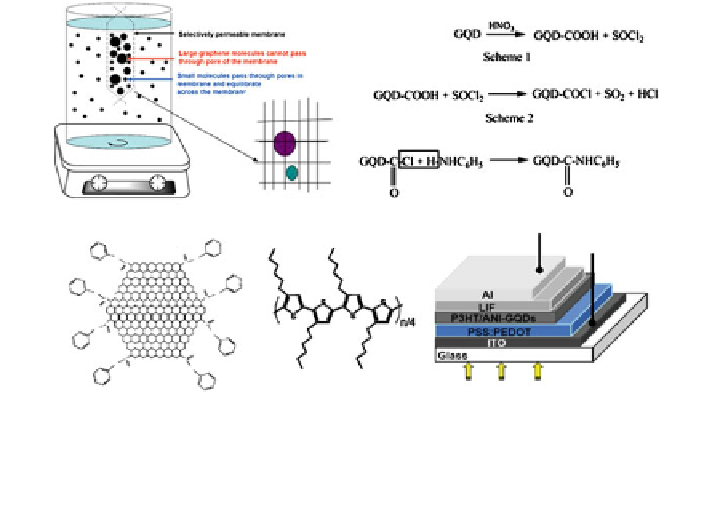Environmental Engineering Reference
In-Depth Information
Fig. 4.7 a Schematic diagram of the graphene dialysis process. b Scheme of functionalization of
graphene quantum dot (GQD) with aniline (ANI). c, d The idealized chemical structure of ANI-
GQD and P3HT. e Schematic of the device with P3HT/ANI-GQD thin film as the active layer and
the structure ITO/PEDOT:PSS (100 nm)/P3HT:ANI-GQD (100 nm)/LiF (1 nm)/Al (70 nm).
Reproduced with permission [
52
]. Copyright 2011, ACS
The study using graphene as acceptor materials has just begun and the
performance of OPVs employing graphene as the acceptor is still lower than that
of fullerene derivatives. But, considering the intrinsic and superior properties of
graphene, it is believed extremely important to advance the studies in this direc-
tion. In this regard, several factors are worth being considered: (1) the size of
graphene. For the BHJ structure devices, the donor-acceptor (D-A) interface
should be maximized for efficient exciton dissociation, and a nanoscale inter-
penetrating network should be formed for efficient charge transport to the elec-
trodes. Thus, a proper size of graphene relative to the donor molecular size is
important to form a well D-A interface and nanoscale interpenetrating network.
(2) The functionalization of graphene and its batch-to-batch reproducibility. It is
necessary to functionalize graphene in order to fabricate the device by solution
process. In general, the performance of organic solar cell is very sensitive to even
extremely little change of each materials and fabrication steps, especially for the
active layer. Thus, the batch-to-batch reproducibility of both graphene and the
functionalized graphene is important. (3) The HOMO/LUMO matching between
graphene acceptor and the donors. The energy level of graphene and functional-
ized graphene are more-or-less different owing to their different sizes, layer
structures, and reduction degrees. In addition, design and synthesis of new donor
polymers matching graphene-based acceptor's energy level are necessary because
most of the donors nowadays are designed based on the acceptor of fullerene
derivatives.

Search WWH ::

Custom Search